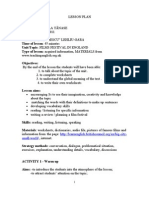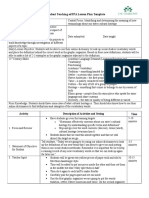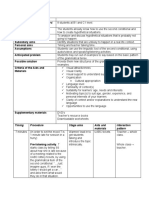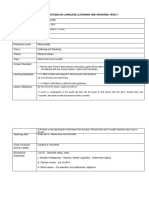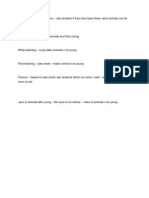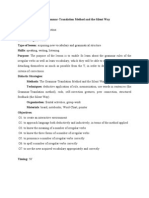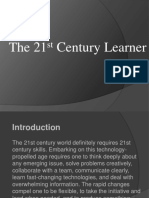Famous Places
Famous Places
Uploaded by
Anonymous lubWipsrWCopyright:
Available Formats
Famous Places
Famous Places
Uploaded by
Anonymous lubWipsrWOriginal Description:
Copyright
Available Formats
Share this document
Did you find this document useful?
Is this content inappropriate?
Copyright:
Available Formats
Famous Places
Famous Places
Uploaded by
Anonymous lubWipsrWCopyright:
Available Formats
Direct Method and Audio-Lingual Method Teacher: Florea Maria-Cristina Grade: 7th Textbook: English Scrapbook Lesson: Famous
Places Type of lesson: acquiring new information and vocabulary; practicing communication skills Skills: reading, speaking, listening Purpose: The purpose of the lesson is to familiarize the students with the continent of Australia by receiving information about it in a both attractive and interactive way, as well as to enable student-student communication and interaction. Didactic Strategies: Methods: Direct Method; Audio-lingual Method Techniques: reading aloud, conversation, chain drill, fill-in-the-blank exercise, transformation drill Organization: individual work, pair-work Materials: textbook, notebook, board Objectives: O1. to create interest in the topic O2. to offer new, attractive information to the students O3. to practise new vocabulary so as to be able to use it appropriately O4. to practise reading comprehension O5. to extract main ideas from a text O6. to ask and answer questions about a text O7. to discuss about the topic of a text Timing: 50
PROCEDURE Warm-up Speaking The T greets the Ss and they greet the T back. The T checks the Ss homework orally, encouraging them when it is required and allowing them to self-correct if necessary. Interaction: T-Ss Timing: 5
Lead-in Speaking O1. to create interest in the topic
Interaction: T-Ss
Timing: 5
The T states the objectives and the subject matter of the lesson, raising the Ss curiosity this way.
Then the T asks the Ss to name all the continents they know. Afterwards, the Ss are asked whether they have ever traveled to another continent or not. If they have, they are told to name it.
Then the T tells the Ss that they will learn new interesting things about an amazing Continent called Australia.
Activity 1: Reading aloud (Direct Method) Reading, listening
Interaction: T-Ss
Timing: 15
O2. to offer new, attractive information to the students O3. to practise new vocabulary so as to be able to use it appropriately O5. to extract main ideas from a text The T names Ss telling them to take turns in reading aloud one paragraph from the text on page 44. When the Ss mispronounce a word, the T interferes by pronouncing the word exactly the same, but using a different intonation, so that the Ss know the word has been pronounced incorrectly. This way, the Ss are given the opportunity to self-correct or to
correct each other. If the Ss try a few times and still cannot pronounce the word correctly, the T interferes, asking all the Ss to repeat after her. All the new words and concomitantly written on the board, as well as in the Ss notebooks, so that the reading comprehension is ensured. Then the Ss have to decide whether the text comes from a novel, a geography book, or a tourist guide, stating the arguments for their choice.
Activity 2: Conversation(Direct)-Chain drill(Audio-lingual) Interaction: T-Ss, S-S Speaking, listening O3. to practise new vocabulary so as to be able to use it appropriately O5. to extract main ideas from a text O6. to ask and answer questions about a text O7. to discuss about the topic of a text
Timing: 8
In order to make sure that the Ss have understood what the text is about, the T asks a question about the text, namely Which is the origin of the name Australia?. She names one S who is supposed to answer the question. The she tells the same S to ask another question about the text to another S, who, after answering it, has to repeat the same operation. If one S does not give the correct answer, he or she loses the right to ask a question himself or herself. This way, the T checks the Ss comprehension of the text, as well as their ability to converse and ask intelligible questions.
Activity 3: Transformation drill (Audio-lingual Method) Speaking
Interaction: T-Ss, S-S
Timing: 7
The T selects a number of 4 sentences in the affirmative from the text, which the Ss then have to put in the interrogative and negative forms.
Then, the T asks the Ss to find interrogative and negative sentences in the text and to put them in the affirmative and either interrogative or negative. The Ss will discover that there are no interrogative or negative sentences, so they have to choose one affirmative sentence and put it in the interrogative and negative.
Activity 4: Fill-in-the-blank Exercise(Direct Method) Reading, speaking
Interaction: T-Ss, S-S
Timing: 8
The Ss are told to solve exercise 2b on page 45 in pairs, deciding which sentence should be placed in each blank. After the pairs have finished their work, the T checks the Ss work, asking for the others pairs to say if they agree or disagree.
Follow-up: Homework
Interaction: T-Ss
Timing: 2
The T tells the Ss that they are supposed to do exercise 2c on page 45. Ss have to read the text again and write two things they did not know about Australia, as well as to write if they would like to go to Australia and why they would or wouldnt like to go there.
You might also like
- Flipped Classroom Past Perfect Tense Lesson Plan Part IIDocument6 pagesFlipped Classroom Past Perfect Tense Lesson Plan Part IIإمحمد السنوسي القزيريNo ratings yet
- Lesson Plan 7Document2 pagesLesson Plan 7MillyalibegovicNo ratings yet
- lp6 When I Grow UpDocument2 pageslp6 When I Grow Upapi-295498767No ratings yet
- Agile Project ManagementToc PDFDocument1 pageAgile Project ManagementToc PDFAnonymous lubWipsrW0% (2)
- Teaching ResumeDocument4 pagesTeaching ResumeAnderson Marantan78% (9)
- 11 Comparing People, Places and ThingsDocument5 pages11 Comparing People, Places and ThingsBernardo Eulogio Bobadilla RodriguezNo ratings yet
- Lesson Plan Listening and SpeakingDocument3 pagesLesson Plan Listening and SpeakingMilz VemNo ratings yet
- English Term 1 Week 1Document19 pagesEnglish Term 1 Week 1آب زیدانNo ratings yet
- Reading Lesson Plan (Pets' World)Document4 pagesReading Lesson Plan (Pets' World)star0157No ratings yet
- Lesson Plan 2 - VocabularyDocument2 pagesLesson Plan 2 - Vocabularymasia22No ratings yet
- Special Occasion SpeechesDocument26 pagesSpecial Occasion Speechesnikki liz gutierrezNo ratings yet
- School FacilitiesDocument3 pagesSchool FacilitiesMilu TintinNo ratings yet
- Lesson Plan British CouncilDocument5 pagesLesson Plan British CouncilAnonymous hVV6Zk0No ratings yet
- Lesson Plan QuatifiersDocument4 pagesLesson Plan QuatifiersLatifah RimaNo ratings yet
- Describing Events, Festivals and CeremoniesDocument5 pagesDescribing Events, Festivals and CeremoniesKrishnan Rao SimmandramNo ratings yet
- Presentation Tesol Colombia IIIDocument60 pagesPresentation Tesol Colombia IIIAndrés MosqueraNo ratings yet
- Lesson Plan For Listening and SpeakingDocument3 pagesLesson Plan For Listening and SpeakingNurul Syafiqah Yaakob100% (1)
- Lesson PlanDocument6 pagesLesson PlanIon PopescuNo ratings yet
- Lesson Plan 7Document13 pagesLesson Plan 7Ramona Iuliana NeculaNo ratings yet
- Lesson Plan SuperlativeDocument7 pagesLesson Plan SuperlativejosiasNo ratings yet
- Lesson Plan - Body PartsDocument5 pagesLesson Plan - Body Partsapi-355947604No ratings yet
- Didactic Sequence: FamiliesDocument14 pagesDidactic Sequence: FamiliesClaudia FernándezNo ratings yet
- Adjectives Lesson PlanDocument4 pagesAdjectives Lesson Planapi-349980598No ratings yet
- Starters 1 Speaking Favorite ToyDocument6 pagesStarters 1 Speaking Favorite ToyphanthiquynhtranNo ratings yet
- Lesson PlanDocument6 pagesLesson PlanAndreea RaduNo ratings yet
- Backwards Design Lesson Plan Template: Objectives/OutcomesDocument2 pagesBackwards Design Lesson Plan Template: Objectives/OutcomesIsaias MartinsNo ratings yet
- RPH Cup-Bi Y1 (Tapak) Lesson 12 RecapDocument2 pagesRPH Cup-Bi Y1 (Tapak) Lesson 12 Recaplizzi100% (1)
- Vocabulary Lesson Plan - SsDocument6 pagesVocabulary Lesson Plan - Ssapi-312645852No ratings yet
- 02 Ee 16867 Ef 442 C 670 BFDocument3 pages02 Ee 16867 Ef 442 C 670 BFapi-490082180No ratings yet
- Lesson Plan Listening and SpeakingDocument7 pagesLesson Plan Listening and SpeakingZechrist ZechariahNo ratings yet
- Cam PET Lesson ReadingDocument11 pagesCam PET Lesson ReadingÝ Nguyễn NhưNo ratings yet
- Project 1 Lesson Plan Around TownDocument8 pagesProject 1 Lesson Plan Around Townjmobando1No ratings yet
- Lesson Plan Have You Got Any PetsDocument2 pagesLesson Plan Have You Got Any PetsmercedesNo ratings yet
- There Isthere Are Lesson PlanDocument5 pagesThere Isthere Are Lesson PlanMadalina AndronacheNo ratings yet
- Great Britain Lesson PlanDocument5 pagesGreat Britain Lesson PlanSilviaNeaguNo ratings yet
- Lesson PlanDocument3 pagesLesson Planapi-287954898No ratings yet
- Adverb Clauses of TimeDocument12 pagesAdverb Clauses of Timehuntclub100% (1)
- 3 Lesson Plan HolidayDocument2 pages3 Lesson Plan HolidayMaíre Ní DhubhdaNo ratings yet
- Health Sickness Lesson Plan PDFDocument7 pagesHealth Sickness Lesson Plan PDFawanderersoulNo ratings yet
- Weebly Flipped Classroom Lesson PlanDocument2 pagesWeebly Flipped Classroom Lesson Planapi-380545611No ratings yet
- Present ContinuousDocument12 pagesPresent ContinuousOana Maria MarianNo ratings yet
- Lesson-Plan Asking and Giving DirectionsDocument3 pagesLesson-Plan Asking and Giving DirectionsGeorgiana GavriliuNo ratings yet
- Lesson Plan Prefixes (Un) in WordsDocument7 pagesLesson Plan Prefixes (Un) in WordsHessa MohammedNo ratings yet
- Classroom ManagementDocument3 pagesClassroom Managementapi-359626316No ratings yet
- 5 - Grammar (Interrogative Pronouns) (KSSR)Document4 pages5 - Grammar (Interrogative Pronouns) (KSSR)Mohamad Adib100% (2)
- Reading To Learn Lesson 1 PracticumDocument3 pagesReading To Learn Lesson 1 Practicumapi-300554601No ratings yet
- Amazing Jobs Lesson PlanDocument3 pagesAmazing Jobs Lesson PlanOlga TurcuNo ratings yet
- Lesson Plan TemplateDocument3 pagesLesson Plan TemplateSonikkaNo ratings yet
- Lesson Plan 1Document1 pageLesson Plan 1api-360610730No ratings yet
- Lesson Plan Relative Clause Junior Secondary1Document6 pagesLesson Plan Relative Clause Junior Secondary1Omar BelazriNo ratings yet
- Listening Speaking Lesson PlanDocument5 pagesListening Speaking Lesson PlanRay E Yu Jun100% (1)
- Guided DiscoveryDocument4 pagesGuided Discoveryapi-315606787100% (1)
- Little SeedDocument4 pagesLittle Seedhoa NguyễnNo ratings yet
- Past Perfect-Lesson PlanDocument6 pagesPast Perfect-Lesson Planzola1975No ratings yet
- English Lesson Plan Form 5 SSTP ModuleDocument3 pagesEnglish Lesson Plan Form 5 SSTP ModuleazrulNo ratings yet
- English 12 Mini Unit OverviewDocument2 pagesEnglish 12 Mini Unit Overviewapi-261024003No ratings yet
- Lesson Plan of Teaching GrammarDocument3 pagesLesson Plan of Teaching GrammarLindsay RichardsNo ratings yet
- Lesson Plan 7th GradeDocument4 pagesLesson Plan 7th Gradegainaru monicaNo ratings yet
- Irregular VerbsDocument4 pagesIrregular VerbsCsuka AndreeaNo ratings yet
- Proiect de Lectie Clasa A VIIIaDocument4 pagesProiect de Lectie Clasa A VIIIaVioleta PopaNo ratings yet
- Direct MethodDocument4 pagesDirect MethodCristinaAnais100% (1)
- Lesson Plans and Activities for Teachers and Tutors of ESL for AdultsFrom EverandLesson Plans and Activities for Teachers and Tutors of ESL for AdultsRating: 4 out of 5 stars4/5 (15)
- Testul Din Anul 2014 - en - Şcoala de Agenţi de Poliţie Vasile Lascăr CâmpinaDocument24 pagesTestul Din Anul 2014 - en - Şcoala de Agenţi de Poliţie Vasile Lascăr CâmpinaAnonymous lubWipsrWNo ratings yet
- Descriere Curs OxfordDocument11 pagesDescriere Curs OxfordAnonymous lubWipsrWNo ratings yet
- Testul Din Anul 2014 - en - Şcoala de Agenţi de Poliţie Vasile Lascăr CâmpinaDocument24 pagesTestul Din Anul 2014 - en - Şcoala de Agenţi de Poliţie Vasile Lascăr CâmpinaAnonymous lubWipsrWNo ratings yet
- Import Import Import Import Import Import ImportDocument3 pagesImport Import Import Import Import Import ImportAnonymous lubWipsrWNo ratings yet
- 825482C54Document4 pages825482C54Anonymous lubWipsrWNo ratings yet
- Thesis Utm SkudaiDocument5 pagesThesis Utm Skudaiameliarichardsonsouthbend100% (2)
- Chapter - 5 Conclusion and SuggestionDocument19 pagesChapter - 5 Conclusion and SuggestionPriyadarshan NairNo ratings yet
- Differences Among The Three Views of Organizational ConflictDocument2 pagesDifferences Among The Three Views of Organizational Conflictpeeyush ananf100% (1)
- 12 2009 Sample Paper Physical EducationbbDocument3 pages12 2009 Sample Paper Physical EducationbbRaja KushwahNo ratings yet
- Fluency 2Document26 pagesFluency 2api-278024645No ratings yet
- Kami Export - VIDEO REVIEW WORKSHEETDocument1 pageKami Export - VIDEO REVIEW WORKSHEETGlory RajiNo ratings yet
- Linguistic Theories of HumourDocument449 pagesLinguistic Theories of HumourVita Khitruk100% (12)
- IEEE 22-Oct - CLE - PlatformDocument10 pagesIEEE 22-Oct - CLE - Platformhero2006machNo ratings yet
- Lesson 3 Homework: Nys Common Core Mathematics CurriculumDocument2 pagesLesson 3 Homework: Nys Common Core Mathematics CurriculumReekhaNo ratings yet
- College Academic Skills in EnglishDocument5 pagesCollege Academic Skills in EnglishjaeNo ratings yet
- Hubungan Pengetahuan, Sikap Dan Usia Dokter Terhadap Kelengkapan Pengisian Berkas Rekam Medis Pada Pasien Bpjs Di Rumah Sakit Aisyiyah BojonegoroDocument7 pagesHubungan Pengetahuan, Sikap Dan Usia Dokter Terhadap Kelengkapan Pengisian Berkas Rekam Medis Pada Pasien Bpjs Di Rumah Sakit Aisyiyah BojonegoroLiooNo ratings yet
- Social Psychology - Symbolic Interaction - Group 4Document31 pagesSocial Psychology - Symbolic Interaction - Group 4bhumishahNo ratings yet
- ReportDocument14 pagesReportSahan PereraNo ratings yet
- Critical Thinking and The Ends of PsychologyDocument11 pagesCritical Thinking and The Ends of PsychologyLidiaMaciasNo ratings yet
- Module 2 - Reading Comprehension - Part IDocument17 pagesModule 2 - Reading Comprehension - Part Iezramaecacacho20No ratings yet
- Students' Perceptions of Quality Learning in A Malaysian University - A Mixed Method ApproachDocument18 pagesStudents' Perceptions of Quality Learning in A Malaysian University - A Mixed Method ApproachMifta Annisa RiskyNo ratings yet
- SIM Action Research ProposaLDocument8 pagesSIM Action Research ProposaLJAMAICA PAULA REGALANo ratings yet
- 5e Science Lesson PlanDocument10 pages5e Science Lesson Planapi-300269240No ratings yet
- Pura Gumangan Gustilo Capacete 2021Document28 pagesPura Gumangan Gustilo Capacete 2021Reynaldo TanglaoNo ratings yet
- Lesson 2Document15 pagesLesson 2aldrin lacuarinNo ratings yet
- Research MemorandumDocument4 pagesResearch MemorandumMaricar Briones PalmonesNo ratings yet
- Examples of Documentation TRANSLITDocument10 pagesExamples of Documentation TRANSLITFotokopiAlfaNo ratings yet
- Wellness Research ResumeDocument2 pagesWellness Research Resumeapi-427627449No ratings yet
- Psy504 Assignment No 1Document2 pagesPsy504 Assignment No 1Ali khanNo ratings yet
- IFAC MMM 2022 - XPS Advanced Modeling and Machine Learning in An Objective To Supplement Process Control OptimizationDocument2 pagesIFAC MMM 2022 - XPS Advanced Modeling and Machine Learning in An Objective To Supplement Process Control OptimizationUsman NiazNo ratings yet
- EAPP (Modules 6-7 Supplemental Material)Document5 pagesEAPP (Modules 6-7 Supplemental Material)Arianne SagumNo ratings yet
- Becoming A Person of Influence Summary John MaxwellDocument6 pagesBecoming A Person of Influence Summary John MaxwellUdodirim ChimboNo ratings yet
- Connected Speech HWDocument12 pagesConnected Speech HWThuy AnhNo ratings yet
- Assignment Brief Unit 12 - Organizational Behaviour PDFDocument8 pagesAssignment Brief Unit 12 - Organizational Behaviour PDFResearch Development and Process Reengineering UnitNo ratings yet












